 The Summer 1968 in London and Zagreb:
Starting or end point of computer art
Christoph Klütsch
International University Bremen
Germany
c.kluetsch@iu-bremen.de
|
 The three N‘s
Georg
Nees
Frieder
N
ake
Michael
Noll
Gausian Quadratic 1962
Polygonzug 13/9/1965 Nr. 3
23-Ecke 1965
Stopped in the early 70s
Stopped in the early 70s
|
 Bense Information aesthetics
•
The aesthetics value of an aesthetic
object can be scientifically measured
•Aesthetic information is an interplay
between order and complexity
•The aesthetic information is part of
(human) communication (Shannon).
•The aesthetic object is a sign
•
Given the rules for generating aesthetic
information, a computer can produce
aesthetic objects/signs
Der Spiegel Nr. 18/1965 S. 151f.
|
 David G.Birkhoff (1884-1944):
A mathematical approach to aesthetics
M=O/C
M = aesthetic mesaurment
O = Order
C = Complexity
|
 Jasia Reichardt: Cybernetic Serendipity I
In: Usselmann, Rainer. The Dilemma of
Media Art: Cybernetic Serendipity at the
ICA London. in: LEONARDO, Vol. 36, No.
5, pp. 389–396, 2003.
Reichardt, Jesia. Cybernetic Serendipity.Studio international. Special Issue. London. 1968. Exhibition catalog
Exhibition catalog
1st edition July 1968, 2nd edition Sept. 1968
|
 Jasia Reichardt
Curator Cybernetic Serendipity
Matko Mestrovic
Curator tendencije
Stuttgart 1960. Computers in Theory and Art.
International Symposium at Akademie Schloss Solitude under the auspices of
the art, science & business program, September 30 to October 2, 2004
|
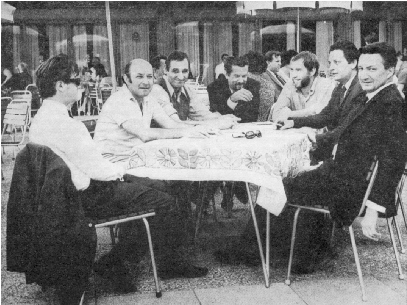 "Computers and Visual Research" Zagreb 3-
4.8.1968. Valoch, Picelj, Alsleben, Franke, Nake,
Kelemen, Richter
(in Bit 3)
Computers & Visual Research
When in 1968 the Galerije Grada
in Zagreb organized the international
colloquy "Computers and Visual Research", this colloquy was a
preparation for the fourth biannual New Tendencies exhibition in
1969.
|
|
?
The first New Tendency exhibition in 1961 was
curated
by
Matko Mestrovic
?
referred to the 1960 manifest from the French "Groupe
de
Recherche d'Art
visuel" including works by the
'Gruppo
N' of
Padua
and the
'Gruppo
T'.
?
"Exat
'51" which was active in former Yugoslavia from 1951-56
?
Connections to Bauhaus, concrete art, constructivism, op art
Roots of Tendecije
|
 Bit 1
programme-information pi-7
The Gallery of Contemporary Art in Zagreb,
where the Movement „New Tendencies“
was
born, is now starting an international
collaboration programme in the field of visual
research by means of computers.
Bit international
(Vol. 1-9; 1968-1972)
Bit 1
"This is the reason why the editors of bit
have started this magazine to present
the theory of information, exact
aesthetics, design, communication
mass media, visual and related
subjects; and to be an instrument of
international cooperation in a field that
is becoming daily less divisible into strict
compartments.”
Basicevic, Dimitrije; Picelj, Ivan (Ed.). The theory of
information and the new aesthetics. Bit international
Vol.1 1968
|
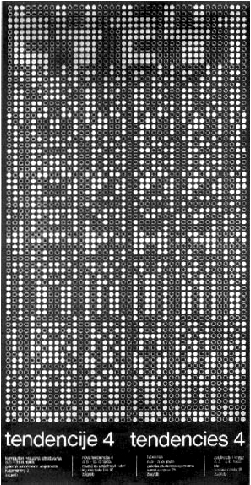 Tendencije 4
Darko Fritz
The fourth Tendencies exhibition (1968/69) was
marked by a further penetration of the idea of a
theory of information and exact aesthetics. The
artistic use of computers was a ‘last try’
of the
Tendencies movement to synchronize its goals as
the ‘scientification
of art’
and ‘bettering the society’
and historical movement of 1968. The exhibition
presented a broad spectrum of computer art only,
hosting the participants from both cold war blocks.
(Darko
Fritz “Amnesia International -
early computer art and the
Tendencies movement”)
Boris Kelemen, co-organizer of "tendencije
4”:
"Finally, this exhibition should not be understood
as the supremacy of technology, but as an
endeavor to overcome the new technology and use
it for new results in the visual field."
Bek, Bozo; Kelemen, Boris (Ed.). Computer and visual research,
catalogue 't4. tendencije 4' (1968 -
69), Zagreb, 1970. Exhibition
catalog
Ivan Picelj poster Tendencije 4
|
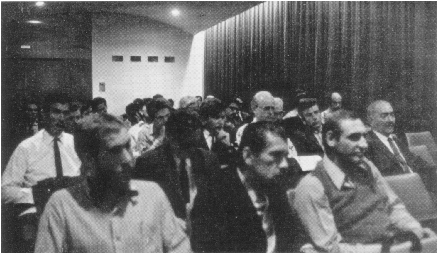 "Computers and Visual Research" Zagreb 3-4.8.1968.
First row: Frieder Nake, Herbert W. Franke, Kurd Alsleben
Colloquy in Zagreb
On the 3. and 4.
August 1968 texts
were presented by:
–
Marc Adrian
–
Kurd Alsleben
–
Alberto Biasi
–
Vladimir Bonacic
–
Herbert W. Franke
–
Branimir Makanec
–
Matko Mestrovic
–
Leslie Mezei
–
Abraham A. Moles
–
Vladimir Muljevic
–
Frieder Nake
–
Vjenceslav
Richter
–
Zdenko Stenberg
–
Bozo Tezak
–
Jiri Valoch
|
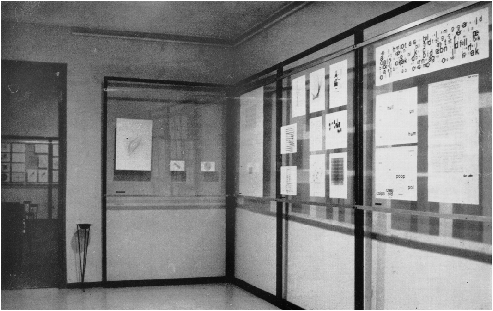 Exhibtion in Zagreb
Herbert W. Franke opened the exhibition.
He stated that the computer is capable of
three kinds of information processing:
creation of order, transformation of order
and destruction of order.
|
|
London Zagreb Manifesto
In April 1969 the Computer Arts Society published with
Gustav Metzger as Editor PAGE. PAGE 1 drew the attention
to the events in Zagreb and on 5. May 1969 together with art
historian Jonathan Benthall
and Gordon Hyde he delivered
the "zagreb
manifesto" to the international symposium
"Computers and Visual Research" in Zagreb. They state:
"It is now evident that, where art meets science and
technology, the computer and related discipline provide
a nexus."
(Hyde, Gordon; Benthall, Jonathan; Metzger, Gustav. Zagreb Manifesto. Bit
international 7. Zagreb 1971 p.4 )
Benthall started 1969 a column about computer art in STUDIO
INTERNATIONAL
-Science and Technology in Art Today (1972)
"Disciples of Bense
and Moles believe that there is a Copernican
revolution round the corner, and that we skeptics will be proved
wrongly eventually"
|
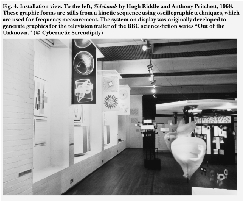 Critical voices: Cybernetic Serendipity
In: Usselmann, Rainer. The Dilemma of Media Art:
Cybernetic Serendipity at the ICA London. in:
LEONARDO, Vol. 36, No. 5, pp. 389–396, 2003.
A critical voice from Zagreb:
"The average visitor could do no more than suspect the
enormous possibilities of methods of computer projecting for the
needs of design in industry. All the same the initiative of the
Institute of Contemporary Arts in the exhibition of cybernetic
serendipity is valuable. The very fact of a more intimate contact
with examples of the use of new techniques is likely to have
started off, even through the quite general message of the
composition of the exhibition, a chain reaction of new ideas and
initiative for the creation of fresh elements in, and relations
towards visual communication."
Putar, Radoslav.
Cybernetic Serendipity. Bit international 1 p.96
A critical voice from London:
"At a time when there is a widespread concern about computers, the advertising and presentation of the
I.C.A.'s
'Cybernetic Serendipity' exhibition as a 'technological fun-fair' is a perfectly adequate
demonstration of the reactionary potential of art and technology. No end of information on computers
composing haiku -
no hint that computers dominate modern war; that they are becoming the most
totalitarian tools ever used on society. We are faces by this prospect-whilst more and more scientists are
investigating the threats that science and technology pose for society, artists are being led into a
technological kindergarten, the idea being that the artist can amuse himself and some other populace with
the gadgetry of modem life."
Metzger, Gustav. Automata in History. Studio International March 1969, 12/6. Vol. 177 No. 907. p.107-109, p.108
|
|
Early Exhibitions 1968
Feb. 1968 intrenationale Wanderausstellung
”Computerart”
organisiert
von Jiri
Valoch
in Brno, Tschecheslowakei
(Charles Csuri, Leslie Mezei, Frieder Nake,
Georg Nees, Michael Noll, and Lubomir Sochor)
“Cybernetic Serendipity”
London 2.Aug -
20.Okt. 1968 (Jasia Reichardt), Institute
for Contemporary Arts. Berichte und Sonderheft Studio International. Später auch in
New York
Symposium Computers and Visual Research
an den Galerije Grada Zagreba in
Zagreb, 3.-4. August 1968. Weitere Aktivitäten bis zum August 1969 in Zagreb.
Herausgabe der Zeitschrift bit international.
Media transformation through electronics. Exhibition of Computer Art 5.-
21.9.1968, Tokio
Gallery Computer Technique Group.
The machine as seen at the end of the mechanical age
. By K. G. Pontus Hulten.
New York, Museum of Modern Art, Nov. 25.1968-
Feb. 9. 1969.
Some more beginnings: Experiments in Art and Technology. Brooklyn
Museum, New York (B. Klüver, J. Martin and R. Rauschenberg, eds. "Some More
Beginnings: An Exhibition of Submitted Works involving Technical
Materials and
Processes." Brooklyn Museum and Museum of Modern Art, Experiments in Art and
Technology, New York, November 26, 1968 to January 5, 1969)
|
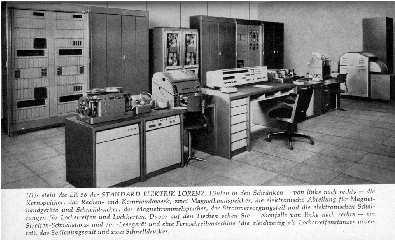 The stuttgart school
Max Bense was the
head of the „Stuttgart
school“. His scientifiy
aesthetic inspired
Frieder Nake and
Georg Nees to do
research in computer
art. They did the first
exhibition about
computer art worldwide.
Georg Nees later wrote
the first dissertation
about computer art,
Frieder Nake might be
considered as the most
successful computer
artist in the first phase.
ER 65 in Stuttgart working place for the stuttgart
school
|
|
Information Aesthetics
Ihe
first 130 pages containing journal "bit international" Max Bense, a
close friend of concrete art artist Max Bill and Abraham Moles
presented their work on the "information aesthetics".
Bense
and Moles tried -
in different ways -
to offer a method to
determine the value of art on a mathematical, scientific, and empirical
bases. Referring to the theories of David Birkhoff
about mathematical
aesthetics and Claude Shannons
Information theory, art was
considered to get it purely aesthetical value from the relation between
order and complexity respectively information and redundancy.
Combined with Norbert Wieners Cybernetic Theory the process of art
criticism should not further relay on subjective opinions, but follow
rational scientific criteria. This theoretical framework (Bense
started his
Aesthetica
in 1954) challenged the 'Stuttgart School of computer art' not
only to consider information aesthetics as an art critics tool, but as a
method to generate art with help by a computer.
|
|
On April 16. 1970, 18 month after the closing of Cybernetic Serendipity,
and 10 month after the closing of tendencije
4, Frieder Nake
announced in PAGE 8: "I stop exhibiting for the present" As a reason he
gives: "It looks as if the capitalist art market is trying to get hold of
computer productions. This would mean a distraction from visual
research." And he concludes further: "the actual production in artistic
computer graphics is repeating itself to a great extent. Really good
ideas haven't shown up for quite a while." And one year later in
PAGE
18 he reinforced his opinion with an article "There should be no
computer art".
PAGE was the Bulletin of the new Computer Arts Society and was
founded in London shortly after Cybernetic Serendipity. Here on
the
one side a new Bulletin for computer art with Gustav Metzger as editor
started, emphasizing the atmosphere of the a new beginning in the arts,
on the other side one representative of the Stuttgart school of computer
art announces the end of his public activities, disappointed about the
unimaginativeness of computer arts and the lack of social responsibility
after the first experimental period.
Starting or end point of computer art?
|
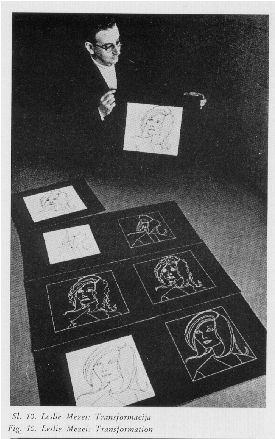 Leslie Mezei
In the January 1966 issue of 'Computers and
Automation', Leslie Mezei
at the University of
Toronto suggested building a network for
sharing information about events connected with
computer art. Shortly afterwards, he published a
bibliography on computer art and in June 1966
the conference "Design and Computer”
was held
at the University of Waterloo, Ontario, Canada.
The conference was organized by Martin
Krampen, who at that time worked at the
Institute of Design at the University of Waterloo
and at the Hochschule für Gestaltung
in Ulm,
Germany.
The participants were: Allen Bernholtz, Edward
Bierstone, Steven A. Coons, William A. Fetter,
Edwin L. Jacks, Kenneth C. Knowlton, Marvin L.
Manheim, A. Michael Noll, Kenneth G. Scheid,
Arthur E. Neuman.
|
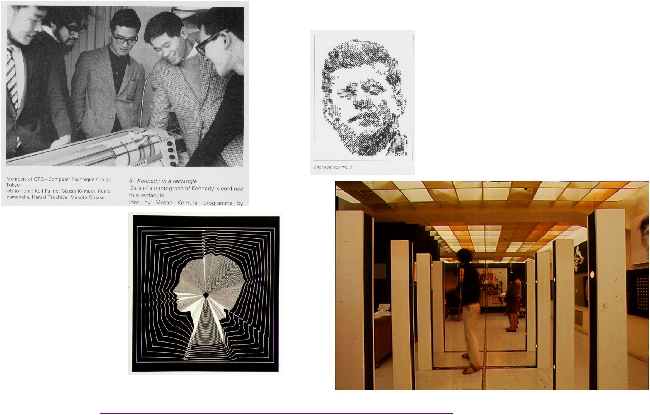 Computer Technique Group
ww
.sccs.chuky
o-u
.ac.jp/~kohm
ura
/CTG/ctg.h
tml
|
|
Early Exhibitions 1965
Georg Nees
Studiengalerie des Studium Generale der Technischen
Hochschule Stuttgart. 5.-19.2.1965
A. Michael Noll and Bela Julesz
"Computer-Generated Pictures" Howard Wise
Gallery New York 6.-24. April 1965
Frieder Nake and Georg Nees
"Computer-Grafik-Programme" 5.-26.11.1965,
Galerie Wendelin Niedlich, Stuttgart, Schmale Strasse 14
Maugham
S. Mason, Bela Julesz
and A. Michael Noll
at the 1965 Fall Joint
Computer Conference, Las Vegas, New Mexico. 30.11-2.12.1965 (Comm. ACM
11 (1965) No. 11, 651)
|
|
Early Exhibitions 1966
Computerkunst, 15.1-15.2.1966 Deutsches Rechenzentrum Darmstadt,
Rheinstrasse 75. Frieder Nake (zeichnerische Darstellungen), Max
V.Mathews und Ben Deutschman (Tonfolgen) und Gerhard Stickel (Texte).
Ausstellung "Programmierung in bildender Kunst und Industrial Design"
begleitend zur Tagung (mit Bense und Moles) der Gesellschaft für exakte
Ästhetik
in Frankfurt in der "Galerie d" (Schwanenhalle des Römers) 11.
Nov. 1966 mit Rüdiger Hartwig, Kurd Alsleben, Frieder Nake und Georg
Nees (Dazu: exakte ästhetik
5: Kunst aus dem
Computer, Stuttgart 1967)
Conference Juni
1966 Design and Planning Waterloo
|
|
Early Exhibitions 1967
Nine Evenings. 1967 dann: E.A.T. (Experiments in Art and Technology) is
formed by Billy Klüver
and Robert Rauschenberg
to promote joint efforts
between artists and engineers, First meeting at Rauschenbergs
studio
"Konstruktive
Tendenzen aus der Tschecheslowakei" Studio Galerie
Frankfurt 3. Nov-15. Dez 1967
Galarie im Hause Behr, Stuttgart, Germany: Febr. 1967 "Computergrafik"
(organized by M. Krampen)
Studio f, Ulm, Germany: 1967 "Computergrafik" (organized by M. Krampen)
|
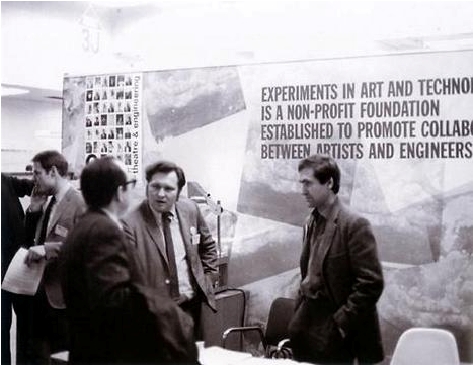 Experiments ind Art and Technology
|
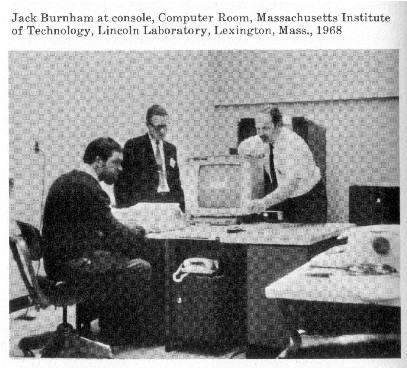 Jack Burnham: Software 1968
|
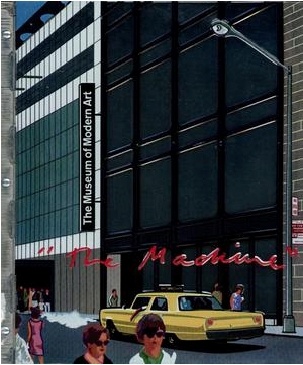 Exhibition Machine
The machine as seen at the end of
the mechanical age. By K. G.
Pontus Hulten. New York, Museum of
Modern Art, Nov. 25.1968-
Feb. 9.
1969.
|
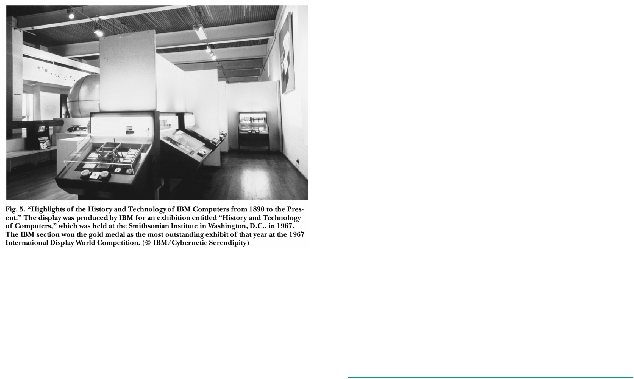 Activities around Cybernetic
Serendipity
In: Usselmann, Rainer. The Dilemma of Media Art:
Cybernetic Serendipity at the ICA London. in:
LEONARDO, Vol. 36, No. 5, pp. 389–396, 2003.
Jasia Reichardt:
„I regret that there are no recordings of the
lectures that were given twice a week on
Thursdays and Tuesdays between 8th
August and 17th October. Among the
speakers were: Frank J. Malina, Herbert
Brun, Everett Ellin, Christopher Evans,
Rex Malik, Meredith Thring, Gordon Pask,
Iannis Xenakis, Abraham Moles, Lionel
Penrose, Robin McKinnon Wood. There
were others too, of course. The person,
who was of special importance to me, was
Christopher Evans of the National Physical
Laboratory, because during our
conversations we found the title:
Cybernetic Serendipity. It was approved by
Roland Penrose only after some
considerable persuasion because he felt
that people wouldn't be able to pronounce
it.“
|